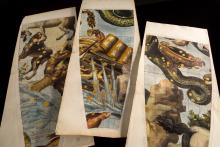Coronelli, Celestial Globe Gores
Image attribution
Source notes
Coronelli, a Franciscan theologian and astronomer who worked in both Italy and France, was a founder of modern geography and an influential maker of celestial and terrestrial globes. Makers of globes printed sheets of map sections, called gores, which were then hand-colored, cut out and glued onto a wood and paper-maché base.
These 9 gores were part of a set of 24 produced at the request of Coronelli’s Accademia Cosmografica to make a 3.5 foot diameter celestial globe. They were designed by Arnold Deuvez and engraved by Jean-Baptiste Nolin in Paris. The set was a reprint of gores which Coronelli printed in Venice in 1688. At the time, Coronelli’s 1688 globe was the largest and most accurate printed celestial globe. The Latin and French legends distinguish this 1693 Paris reprint from the 1688 originals, which were in Italian.
These gores are reprints made in 1800 using the original 1693 plates.
In the Epitome Cosmographica, Coronelli explained how to use celestial and terrestrial globes and his techniques for constructing them. The Epitome describes how Coronelli famously constructed a pair of terrestrial and celestial globes for Louis XIV which measured more than 12 feet in diameter.




